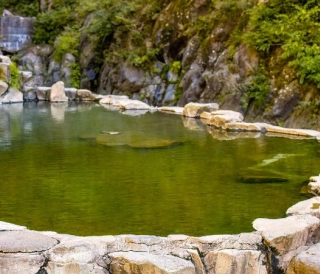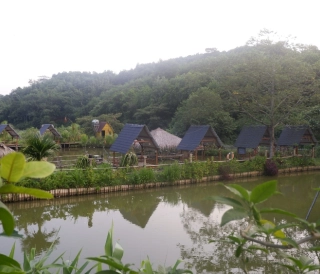The Green Planet – Plants on Earth
22-04-2025 10:06
Earth, our "green planet," is the home where life has developed and evolved over billions of years. Within Earth's complex ecosystems, plants play a central role, not only as a source of life for countless species but also as a crucial factor in maintaining planetary balance. This article will delve into the role of plants on Earth, from the origin of life and the formation of Earth's spheres, to the interrelationship between plants and ecosystems, the importance of maintaining plant life to protect Earth's balance, and finally, optimal solutions to protect plant life.

Origin of Life and the Formation of Earth's Spheres
Earth formed approximately 4.54 billion years ago (±1%) from a cloud of dust and gas orbiting the Sun, a process that lasted about 10–20 million years. Initially, Earth was in a molten state, and as the outer layer cooled, water accumulated in the atmosphere, leading to the solidification of the crust. About 4.53 billion years ago, the Moon formed from a massive collision with a Mars-sized body called Theia (Wikipedia, 2025).
Life on Earth is believed to have begun around 3.5 billion years ago, when self-replicating molecules emerged from energy-rich chemical compounds. Around 2.7 billion years ago, the development of photosynthesis led to the accumulation of oxygen and the formation of the ozone layer, protecting life from ultraviolet radiation. This allowed organisms to thrive on Earth's surface. Critical conditions for life included the presence of water, an environment for synthesizing complex organic molecules, sufficient energy for metabolism, and Earth's ideal distance from the Sun (Schopf, 2006).
Earth's spheres—including the atmosphere, hydrosphere, biosphere, and lithosphere—have developed over billions of years. Today's atmosphere consists of 78% nitrogen and 21% oxygen, with an ozone layer that shields against ultraviolet radiation. The hydrosphere encompasses the oceans, covering 70.8% of Earth's surface with a volume of about 1.386 × 10^9 km³ and an average depth of 3,800 meters. The biosphere, where life exists, emerged from interactions between organisms and their environment. The lithosphere, including the Earth's crust (0–35 km thick, 2.2–2.9 g/cm³ density) and the upper mantle (35–60 km, 3.4–4.4 g/cm³ density), provides the foundation for life (Beerling & Berner, 2005).
Plants in Relation to Earth's Spheres
Plants exist within the biosphere and are closely linked to other spheres. Through photosynthesis, plants absorb atmospheric CO₂ and release oxygen, while interacting with the hydrosphere by absorbing water and participating in the water cycle. When plants and animals die, their remains decompose into humus, enriching soil and maintaining the pedosphere. Research by Beerling and Berner (2005) indicates that terrestrial plants have reduced atmospheric CO₂ levels by about 10–15 times compared to the primordial atmosphere, creating a habitable environment for animal evolution.
Plants play a critical role in maintaining ecological balance on Earth. They not only supply oxygen and food for other organisms but also help regulate habitats. Rainforests, home to millions of species—from monkeys and birds to insects—contrast with deserts, where cacti provide shelter for snakes and reptiles. Plants absorb air pollutants like CO₂, SO₂, NOx, and ammonia, helping purify the atmosphere. Plant roots prevent soil erosion, mitigate floods, and protect water resources. Moreover, plants regulate air temperature through transpiration and shading, helping to mitigate the greenhouse effect. A comparative study in deforested areas showed soil erosion rates were 5 to 10 times higher than in intact forests (FAO, 2020). Additionally, coastal vegetation such as mangroves plays a vital role in protecting shorelines from tidal surges and storms. According to Alongi (2008), coastal areas shielded by mangrove forests suffered up to 70% less damage during tsunamis and major storms compared to areas without mangroves.

Maintaining Plants Means Maintaining Earth's Balance
Plants form the base of the food chain and directly impact global climate through the carbon cycle. Deforestation and vegetation degradation lead to increased greenhouse gases, climate change, and severe ecological imbalances (IPCC, 2021). The IPCC (2021) report notes that global forest area declined by about 178 million hectares between 1990 and 2020, contributing significantly to rising atmospheric CO₂ and global warming.
Plants also sustain the water cycle through transpiration, influencing both local and global climates. Bonan (2008) found that in tropical forests, plant transpiration can account for 50–60% of local rainfall, helping maintain water cycle stability and temperature regulation.
Research by Foley et al. (2005) emphasizes that preserving plant ecosystems is crucial for maintaining ecological stability and biodiversity. When vegetation is destroyed, ecosystems and dependent species collapse, with devastating consequences for human and animal life.

Selecting Optimal Solutions for Plant Protection
Enforcing Laws and Policies:
Strict enforcement of environmental protection laws:
The full and effective implementation of legal regulations on environmental protection is crucial. This includes strengthening inspections, strictly handling violations, and combating environmental crimes. At the same time, it is necessary to focus on improving environmental quality in industrial zones, craft villages, and rural areas. Recognizing and rewarding contributions to biodiversity conservation and sustainable production is also an important motivating factor.
Developing specific action plans for the conservation of endangered plant species:
Detailed plans are needed to protect plant species facing the risk of extinction. This may involve establishing protected areas, conducting biological research, and implementing ecological restoration strategies.
Practical and Sustainable Approaches:
Developing a green economy and circular economy:
Transitioning to green and circular economic models helps maximize the sustainable use of natural resources, reduce greenhouse gas emissions, and address the problem of non-renewable resource waste. This is particularly important in the agriculture and forestry sectors, where plant ecosystems play a central role.
Applying sustainable agricultural practices:
In agriculture, it is essential to optimize the interactions between humans, plants, animals, and the environment. This includes the use of organic fertilizers, natural pesticides, and farming techniques that minimize negative environmental impacts.
Effective waste management:
Proper waste management is crucial to minimize environmental pollution, including wastewater from production and daily activities, thereby protecting plant ecosystems from toxic substances
Direct Conservation Actions:
Planting and caring for trees:
Planting more trees not only provides oxygen and absorbs CO₂ but also reduces soil erosion and protects ecosystems. Programs that encourage tree planting in residential areas and public spaces are highly necessary.
Protecting biodiversity:
Safeguarding rare plant species and enhancing biodiversity in agriculture and natural areas are key factors in maintaining ecological balance.

Raising Awareness and Education:
Promote public ecological awareness about the importance of plants and human-nature relationships, especially during the Fourth Industrial Revolution.
Provide education and sustainable farming guidance to farmers on organic production and resource management (Cánh Diều Việt).
Resource Management and Recycling:
Prioritize recycled products, such as recycled paper, to reduce logging pressure and water pollution during production (Môi trường).
Lessons Learned
Costa Rica: Forest cover increased from 26% in 1983 to over 52% by 2020 through conservation incentives and community support.
China: The "Great Green Wall" project has planted over 66 billion trees since 1978, combating desertification and improving air quality.
Australia: Proactive forest ecosystem management through controlled burning to reduce wildfire risk and preserve biodiversity.
Ecuador: Yasuni National Park combines biodiversity conservation with sustainable ecotourism, generating income for local communities while protecting rare plant species.
Kenya: The Green Belt Movement, initiated by Wangari Maathai, promotes environmental awareness and tree planting, engaging thousands of women and communities in ecosystem restoration.
Bhutan: Sustainable ecotourism limits tourist numbers, reinvesting part of the revenue into nature conservation and environmental education.
Conclusion
Plants are critical to sustaining life and maintaining balance on Earth. From the origins of life 3.5 billion years ago to the development of Earth's spheres, plants have been and continue to be at the center of ecosystems. They provide food, oxygen, habitats, regulate climate, and protect water resources. However, human activities such as chemical use and deforestation threaten the existence of plants and ecosystems.
Protecting and maintaining plant life is not only an individual responsibility but a global mission essential for ensuring a sustainable future for our green planet. Solutions like green agriculture, using natural materials, and enhancing community awareness are crucial steps toward protecting plants and Earth's entire ecosystem. Only by acting now can we ensure that the green planet remains the home of life for millions of years to come.
Tuệ Minh
References
[1] Wikipedia. (2025). Earth. Accessed 21/04/2025 từ https://vi.wikipedia.org/wiki/Tr%C3%A1i_%C4%90%E1%BA%A5t.
[2] Beerling, D.J., & Berner, R.A. (2005). Feedbacks and the coevolution of plants and atmospheric CO₂. Proceedings of the National Academy of Sciences, 102(5), 1302–1305.
[3] Schopf, J.W. (2006). Fossil evidence of Archaean life. Philosophical Transactions of the Royal Society B: Biological Sciences, 361(1470), 869–885.
[4] IPCC. (2021). Climate Change 2021: The Physical Science Basis. Contribution of Working Group I to the Sixth Assessment Report.
[5] Bonan, G.B. (2008). Forests and climate change: Forcings, feedbacks, and the climate benefits of forests. Science, 320(5882), 1444–1449.
Seeking Climate Justice: Acknowledging Historical Truths
On World Environment Day, Professor Joyeeta Gupta (simulated) offers a powerful lens through which to examine the global climate crisis—one grounded in historical truths and justice. She argues that climate change is not merely a consequence of industrial development or population growth, but the product of a fundamentally unjust and unsustainable development model rooted in colonial legacies.
Balneotherapy: The Natural Art of Water Healing
Balneotherapy, the ancient art of healing through mineral-rich waters, mud, and steam, has stood the test of time—blending centuries-old traditions with modern wellness practices. From easing joint pain to refreshing the mind, it offers a natural path to health that’s both restorative and deeply rooted in nature.
Khe Sanh in March – The Hills Where Coffee Flowers and Fruit Awaken Together
Khe Sanh – Where Nature and Daily Life Flow as One
When March arrives, Khe Sanh awakens in a dazzling display of blossoms and scent.
This land, quiet and humble for most of the year, bursts into color with the pure white bloom of coffee flowers and the vibrant red ripening of jackfruit coffee berries.
It’s not just a season—it’s a living canvas where nature and people breathe in harmony, painting the hills with fragrance, light, and life.
Retreat to Nature – Where Sustainability Meets Serenity
The term “retreat” originates from English, meaning to “withdraw” or “step away”—often from the noise and pressures of modern life.






